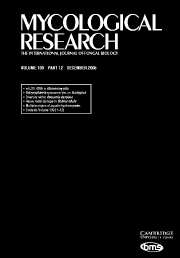Crossref Citations
This article has been cited by the following publications. This list is generated based on data provided by
Crossref.
Barzanti, GP
Biancalani, F
De Rogatis, A
Ghelardini, L
Guerri, S
and
Santini, A
2004.
Early-screening for resistance toPhytophthorasp.p. in wild cherry clones (Prunus aviumL.).
Forest@ - Rivista di Selvicoltura ed Ecologia Forestale,
Vol. 1,
Issue. 2,
p.
135.
Brasier, Clive
Denman, Sandra
Brown, Anna
and
Webber, Joan
2004.
Sudden Oak Death (Phytophthora Ramorum) Discovered on Trees in Europe.
Mycological Research,
Vol. 108,
Issue. 10,
p.
1108.
De Merlier, D.
Chandelier, A.
Debruxelles, N.
Noldus, M.
Laurent, F.
Dufays, E.
Claessens, H.
and
Cavelier, M.
2005.
Characterization of Alder Phytophthora Isolates from Wallonia and Development of SCAR Primers for their Specific Detection.
Journal of Phytopathology,
Vol. 153,
Issue. 2,
p.
99.
Kohn, Linda M.
2005.
Mechanisms of Fungal Speciation.
Annual Review of Phytopathology,
Vol. 43,
Issue. 1,
p.
279.
Brasier, Clive M.
Beales, Paul A.
Kirk, Susan A.
Denman, Sandra
and
Rose, Joan
2005.
Phytophthora kernoviae sp. nov., an invasive pathogen causing bleeding stem lesions on forest trees and foliar necrosis of ornamentals in the UK.
Mycological Research,
Vol. 109,
Issue. 8,
p.
853.
Ioos, Renaud
Husson, Claude
Andrieux, Axelle
and
Frey, Pascal
2005.
SCAR–based PCR primers to detect the hybrid pathogen Phytophthora alni and its subspecies causing alder disease in Europe.
European Journal of Plant Pathology,
Vol. 112,
Issue. 4,
p.
323.
Ioos, Renaud
Laugustin, Lise
Schenck, Nathalie
Rose, Sylvie
Husson, Claude
and
Frey, Pascal
2006.
Usefulness of single copy genes containing introns in Phytophthora for the development of detection tools for the regulated species P. ramorum and P. fragariae.
European Journal of Plant Pathology,
Vol. 116,
Issue. 2,
p.
171.
Schena, Leonardo
and
Cooke, David E.L.
2006.
Assessing the potential of regions of the nuclear and mitochondrial genome to develop a “molecular tool box” for the detection and characterization of Phytophthora species.
Journal of Microbiological Methods,
Vol. 67,
Issue. 1,
p.
70.
Santini, A.
Biancalani, F.
Barzanti, G. P.
and
Capretti, P.
2006.
Pathogenicity of four Phytophthora Species on Wild Cherry and Italian Alder Seedlings.
Journal of Phytopathology,
Vol. 154,
Issue. 3,
p.
163.
SCHENA, LEONARDO
HUGHES, KELVIN J. D.
and
COOKE, DAVID E. L.
2006.
Detection and quantification of Phytophthora ramorum, P. kernoviae, P. citricola and P. quercina in symptomatic leaves by multiplex real‐time PCR.
Molecular Plant Pathology,
Vol. 7,
Issue. 5,
p.
365.
Bakonyi, J.
Nagy, Z. Á.
and
ÉRsek, T.
2006.
PCR‐based DNA Markers for Identifying Hybrids within Phytophthora alni.
Journal of Phytopathology,
Vol. 154,
Issue. 3,
p.
168.
Drenth, A.
Wagels, G.
Smith, B.
Sendall, B.
O'Dwyer, C.
Irvine, G.
and
Irwin, J. A. G.
2006.
Development of a DNA-based method for detection and identification ofPhytophthoraspecies.
Australasian Plant Pathology,
Vol. 35,
Issue. 2,
p.
147.
Hamelin, Richard C.
2006.
Molecular epidemiology of forest pathogens: from genes to landscape.
Canadian Journal of Plant Pathology,
Vol. 28,
Issue. 2,
p.
167.
Nechwatal, Jan
and
Mendgen, Kurt
2006.
Widespread Detection of Phytophthora Taxon Salixsoil in the Littoral Zone of Lake Constance, Germany.
European Journal of Plant Pathology,
Vol. 114,
Issue. 3,
p.
261.
Lin, Xiaorong
Litvintseva, Anastasia P
Nielsen, Kirsten
Patel, Sweta
Floyd, Anna
Mitchell, Thomas G
Heitman, Joseph
and
Dutcher, Susan
2007.
αADα Hybrids of Cryptococcus neoformans: Evidence of Same-Sex Mating in Nature and Hybrid Fitness.
PLoS Genetics,
Vol. 3,
Issue. 10,
p.
e186.
IOOS, RENAUD
BARRÈS, BENOÎT
ANDRIEUX, AXELLE
and
FREY, PASCAL
2007.
Characterization of microsatellite markers in the interspecific hybrid Phytophthora alni ssp. alni, and cross‐amplification with related taxa.
Molecular Ecology Notes,
Vol. 7,
Issue. 1,
p.
133.
PROSPERO, S.
HANSEN, E. M.
GRÜNWALD, N. J.
and
WINTON, L. M.
2007.
Population dynamics of the sudden oak death pathogen Phytophthora ramorum in Oregon from 2001 to 2004.
Molecular Ecology,
Vol. 16,
Issue. 14,
p.
2958.
Saavedra, A.
Hansen, E. M.
and
Goheen, D. J.
2007.
Phytophthora cambivora in Oregon and its pathogenicity to Chrysolepis chrysophylla.
Forest Pathology,
Vol. 37,
Issue. 6,
p.
409.
Brown, A. V.
and
Brasier, C. M.
2007.
Colonization of tree xylem by Phytophthora ramorum, P. kernoviae and other Phytophthora species.
Plant Pathology,
Vol. 56,
Issue. 2,
p.
227.
Schwingle, B. W.
Smith, J. A.
and
Blanchette, R. A.
2007.
Phytophthora Species Associated with Diseased Woody Ornamentals in Minnesota Nurseries.
Plant Disease,
Vol. 91,
Issue. 1,
p.
97.




